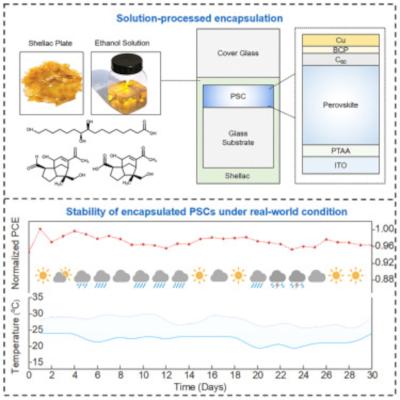Perovskite Solar - Page 28
TandemPV raises $6 million to accelerate perovskite PV commercialization
TandemPV has raised $6 million, bringing its total to $27 million in venture capital and government support. The Company will use the funds to advance research and development and plans to build its first manufacturing facility.
The funding round was led by existing investor Planetary Technologies, an early-stage venture capital firm with deep expertise in climate tech. Other institutional investors participated, including new investor Uncorrelated Ventures, as well as executives from a variety of corporate sectors and such solar industry leaders as Tom Werner, former chairman, president and CEO of SunPower Corp.
Researchers examine defect passivators for thermally stable metal-halide perovskite films
Researchers at the University of Michigan and Arizona State University have examined bulky "defect pacifying" molecules as a way to increase the stability and overall lifespan of perovskite materials.
The team expects this novel way of preventing perovskite materials from degrading quickly could help enable solar cells estimated to be two to four times cheaper than today's thin-film solar panels.
China-based RenShine Solar launches new 150MW perovskite PV line
China-based RenShine Solar has announced the completion of its 150MW perovskite PV module project in Changsgu, which started in April 2023.
The Company said it has switched on the 150 MW perovskite cell production line. The China-based perovskite manufacturer aims to achieve mass-scale production of perovskite panels with a size of 1.2m*0.6m and an efficiency of 20% by mid-2024. It said it will focus on the development of gigawatt-level production lines to further expand its capacity.
Researchers shed light on the reasons for perovskite solar cells' high efficiency
Researchers at China's Sun Yat-sen University, Spain's Universidad de Valencia, Germany's Forschungszentrum Jülich, and University of Duisburg-Essen have used transient photoluminescence measurements to show that the loss of charge carriers in perovskite cells follows different physical laws than those known for most semiconductors. This may be one of the main reasons for their high level of efficiency.
“An important factor here is the question of how long excited charge carriers remain in the material, in other words their lifetime,” explains Thomas Kirchartz. “Understanding the processes is crucial to further improving the efficiency of perovskite-based solar cells”. Kirchartz is the head of a working group on organic and hybrid solar cells at Forschungszentrum Jülich’s Institute of Energy and Climate Research (IEK-5).
Researchers develop new encapsulation strategy based on shellac
Researchers at the Chinese Academy of Sciences (CAS), Shanghai Jiao Tong University School of Medicine and the University of Electronic Science and Technology of China (UESTC) have presented a simple and economical encapsulation strategy with shellac to protect perovskite solar cells (PSCs) under various accelerated degradation experiments.
The shellac-encapsulated (SE) PSC modules reportedly passed outdoor stability, UV preconditioning, and hail tests according to the International Electrotechnical Commission 61215 standard (IEC61215).
Researchers develop strategy for constructing near-edge states for stable and efficient perovskite solar cells
Electronic band structure engineering of metal-halide perovskites (MHP) is at the heart of fundamental materials research and photovoltaic applications. However, reconfiguring the band structures in MHPs for optimized electronic properties remains challenging. Researchers at Wuhan University have reported a generic strategy for constructing near-edge states to improve carrier properties, leading to enhanced device performances.
The near-edge states are designed around the valence band edge using theoretical prediction and constructed through tailored material engineering. These states are experimentally revealed with activation energies of around 23 milli-electron volts by temperature-dependent time-resolved spectroscopy.
Researchers develop unique ACIGS solar cells for better tandem perovskite/CIGS technology
Researchers from the Daegu-Gyeongbuk Institute of Science and Technology (DGIST) in South Korea have developed silver-alloyed CIGS solar cells (ACIGS) that can be beneficial for applications in perovskite-CIGS tandem PV devices.
The silver-alloyed photovoltaic cell based on copper, indium, gallium and selenium (CIGS) thin-film technology and can reach a remarkable power conversion efficiency of 17.7% without applying post-deposition treatments or anti-reflection coatings.
Researchers develop new passivation technique for better lead-free perovskite-silicon tandem solar cells
Researchers from Japan's University of Electro-Communication and CAR MATE MFG. CO. have developed a lead-free tin sulfide solar cell that is intended for applications in tandem perovskite-silicon PV devices.
Using a new passivation technique based on the use of phenylsilane (PhSiH3) as a reducing agent, the scientists were able to considerably increase the cell's efficiency compared to a reference device with no PhSiH3 treatment.
Project P4SPACE to advance development of perovskite photovoltaics for space environment
The EU-funded P4SPACE project started in April 2023 and will run until the end of March 2025.
The project will develop and scale-up PSCs with high performance and durability in harsh space environments. It will aim to deliver sustainable PV technology for any present and future space environment application.
Researchers report sulfonium-based treatment for perovskite films that yields extremely stable perovskite solar cells
A collaborative team of researchers, including ones from Uppsala University, CNR-SCITEC, Fraunhofer ISE, University of Cambridge, Empa, EPFL and additional institutes, recently introduced an unexplored dimethylphenethylsulfonium iodide (DMPESI) molecule to post-treat formamidinium lead iodide perovskite films. The treated films showed outstanding stability upon light soaking and remarkably remains in black-phase after 2 years ageing under ambient condition without encapsulation.
Fresh and 24-month aged unencapsulated perovskite film (1.0 cm by 2.0 cm) without and with DMPESI treatment of different concentrations. Image from Nature Energy
The DMPESI-treated PSCs deliver a breakthrough record in operational stability of highly-efficient PSCs with less than 1% performance loss after more than 4500 h at maximum power point tracking, yielding an extraordinarily high theoretical T80 of over 9 years under continuous 1-sun illumination, which would correspond to a photon flux of an outdoor PV installation in Sweden or Germany (1,000 kWh m−2 per year) of over 78 years.
Pagination
- Previous page
- Page 28
- Next page





